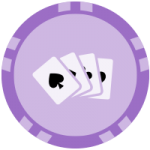The

title of this article may at first seem contradictory since we often think of balance and exploitation as opposite ends of the spectrum. In many regards this is true, and this article will be based around improving the exploitative side of our game.
Awareness of Balanced Lines
The reason why we will be discussing balance is very simply that balanced play likely involves lines that we are currently not taking. As a simple example let's consider a situation where we open in the SB and BB calls. We decide to check as the PFR.
As outlined in other articles many players simply never check/raise in this spot and also rarely check/call. If they do check/call it will often be with a very specific type of
showdown-value hand such as second pair or top-pair-weak-kicker.
If we follow a balanced strategy we should be checking the following types of hands -
a) Air with the intention of check/folding
b) Strong made hands with the intention of check/calling or check/raising
c) Decent backdoor potential hands with the intention of check/calling or check/raising
d) Mid-strength showdown value-hands with the intention of check/calling (although these should be cbet with some frequency)
Most players incorporate option (a) and option (d) into their strategy. Fewer incorporate option (b), and option (c) is only really incorporated by the minority. Essentially most players will be check/folding with a huge percentage after they check as the PFR.
This means that their checking range is undefended and they are exploitable. But the bottom line is, in most cases we don't care if we are exploitable unless playing against very good opposition. Adjusting purely for the sake of defending our checking range would be considered an adjustment based on balance, and as mentioned in the outset we are interested in exploitation.
However, understanding the basic principles regarding balanced play in this situation will allow us to become aware of additional lines that can be used for exploitative reasons.
Increased Exploitation
When we see a player check/folding with a high frequency after checking as the PFR in a lower limit game this shouldn't bother us in the slightest from a balance point of view. That player is probably not getting exploited. It should bother us for an entirely different reason.
Let's imagine we see the following stats after a player checks as the PFR -
- check/call – 20%
- check/raise – 0%
- check/fold – 80%
These stats are actually fairly typical of many players at the lower limits. It should bother us for the following reason -
There would have been a time in this players career where he would have had the absolute perfect opportunity to go for a check/raise rather than a
cbet. Perhaps he was playing vs an opponent who always bets vs missed cbets. It should be somewhat obvious that the expectation of both check/raising as a bluff and check/raising for value are likely to go up, because we capture an extra bet from our opponent this way.
We can therefore categorically state that a player with the above stats is not exploiting this opportunity.
In other words, despite the fact that we don't care about balance, the complete lack of balance here indicates that such a player is not capitalising on his exploitative opportunities. We may not have realized this if we didn't first consider which lines were available as part of a balanced strategy.
The same could be true regarding check/calling. If we know that our opponent loves to
3-barrel bluff vs players who check as the PFR it should be very obvious that our expectation with nutted hands goes up if we check and allow our opponent to bluff. We will still extract value from his made hands this way but we will also take a decent chunk of money from his bluffs which we may not have been able to do otherwise if we'd taken our default approach of cbetting with the nuts.
Many players will always bet/bet/bet by default with nutted hands at lower limits. This is perfectly fine as a default, but assuming we have decent reads on our opponents this can potentially be burning money.
Application to Other Areas
We

don't purely want to talk about checking as the PFR. This is only one small area of our overall strategy. We ideally want to take this concept and apply it to other areas of our game where we are not taking all the available lines at our disposal.
For example when was the last time we cbet the flop and then check/raised the turn? It can sometimes be worth running a filter for this particular line because there are many players out there who have never used this line in their entire career. And yet it is likely correct to take this line when analyzing the game from a balance perspective, so that should tell us the line can be used for exploitative reasons.
The main difference when considering an exploitative approach to a balanced one is that we are free to weight this line in this most profitable way.
So if we find a certain opponent would never fold to a turn check/raise in this spot it should tell us that we can likely check/raise a range which is purely weighted towards value hands. This would be incorrect from a balance perspective, but we don't really care about balance vs most opponents.
The important thing is that we understand which lines should be part of a balanced strategy and find ways to incorporate these lines as part of an exploitative strategy.
More Lines = More Profit
Despite the fact that a certain line can be clearly higher EV when considered form an exploitative point of few, having additional lines (up until a point) can increase the quality of our overall game-plan. We can take a very simple example of this by considering our preflop response when facing an open-raise.
Most players inherently understand that it is correct to have both a cold-calling and a 3betting range.
But why? Well what would happen if we
3-bet our entire continuing range? Likely our 3betting frequency would become way too high. Again this is only an issue when we consider it from a balance point of view, but it should teach us something about exploitative play.
A good opponent would quickly realize we are 3-betting way too frequently and start to play back at us. But what if we decided instead to
cold-call our entire continuing range? Now we would be missing out on some of the advantages that 3-betting gives us, such as preflop
fold-equity and extracting value with premiums.
The best strategy is clearly one that incorporates both cold-calling and 3betting. This strategy allows us to defend the widest possible
range without making any critical errors with our overall strategy. The more lines we incorporate the wider the range of possible hands we can play profitably and hence the overall profitability of our game-plan increases.
This also has the additional advantage of making us tougher to play against, which is an exploitative advantage. If we always limit our postflop lines to one of a few different possible lines then our opponents are going to figure us out much more quickly. Mixing things up and using a wide variety of different lines is going to make us a much tougher player to play against. Our opponents will make more mistakes against us and our exploitative game is hence improving as a result.
So if we are the type of player who always either check/calls or check/folds the turn after cbetting the flop and checking the turn we are -
- Not maximizing our ability to play the widest possible range profitably
- Not taking advantage of some obvious exploitative situations
- Not making ourselves as tough to play against as we otherwise could be.
Other Lines
The great thing about exploitative play is we can even further expand on the possible lines that we consider taking. Once we throw balance out of the window, pretty much anything goes if it maximizes our
EV in isolation.
To give an example, take
donk-betting. It's unclear at this stage whether it's considered correct in theory to open up a donk-betting range on the flop. The general consensus seems to be that if the flop texture connects harder with our range than our opponents then it is probably OK to open up a donk-betting range. But whether this is theoretically correct or not, we don't need to care when playing exploitatively.
The fact is the vast majority of players either rarely or never donk-bet the flop in a heads up situation. Checking to the PFR has become very standard, and it shouldn't be. We are essentially closing off our minds to a decent line that we can take exploitatively.
An important stat to keep on the main
HUD is “fold to flop donk-bet”. We want to be ever aware of exploitative opportunities here. Imagine we flop undercards and we have no fold-to-donk stat on our HUD.
Our standard game-plan is nearly always going to be to check/fold in this situation. We could naturally open up a popup to see what our opponent's “fold-to-donk” stat is and make an exploitative decision, but do we really want to open up a popup every single time we are OOP as the cold-caller. This would be tedious and is not efficient use of the resources we have available.
Having the stat clearly visible on our main HUD should make the idea of exploitative donk-bets much more conceivable. Now, when we flop undercards, it's pretty easy to fire off a donk-bet when we notice our opponent's fold-to-donk stat is very high. We'd normally have been check/folding in this spot, but our awareness of the lines available to us has now increased and we can make a better exploitative decision.
Mental Blocks
Something

like the above example can seem really obvious once we put it down in writing. But the fact is that most players suffer from a mental block in situations like this along with a variety of other postflop situations.
Once we get into the habit of not taking a line for a long period of time, we start to act as if that line doesn't exist any more. We may have considered the line when we first started out and were thinking more deeply about the game, but now after years of being conditioned by various training videos and books, we have completely blotted out any possibility of taking the line.
The only way we can remove such a mental block is with conscious effort. This is something we can experiment with next time we are at the table.
It might be a good idea to reduce the number of tables we play when doing this since the results can be surprising. Rather than continuing to take our standard lines, pause before each decision.
Don't consider what is standard, consider what is possible. Are there any lines we never or rarely take in this spot? What is the reason? Are those lines inferior? Why are they inferior? If we are not convinced that they are actually inferior, what are the advantages? Might this be a better solution than the “standard” line we most often take? What does our opponent expect us to do? How can we defy his expectations? What do his stats tell us about his leaks? How can we exploit these leaks? Would this involve a line we don't take as standard?
To do this exercise justice we will likely be using our time bank much more than usual. The worst case scenario is we simply take a little longer on some of our decisions than normal. In the best case scenario we develop strong exploitative lines which were not initially part of our game-plan.
 title of this article may at first seem contradictory since we often think of balance and exploitation as opposite ends of the spectrum. In many regards this is true, and this article will be based around improving the exploitative side of our game.
title of this article may at first seem contradictory since we often think of balance and exploitation as opposite ends of the spectrum. In many regards this is true, and this article will be based around improving the exploitative side of our game.  don't purely want to talk about checking as the PFR. This is only one small area of our overall strategy. We ideally want to take this concept and apply it to other areas of our game where we are not taking all the available lines at our disposal.
don't purely want to talk about checking as the PFR. This is only one small area of our overall strategy. We ideally want to take this concept and apply it to other areas of our game where we are not taking all the available lines at our disposal. like the above example can seem really obvious once we put it down in writing. But the fact is that most players suffer from a mental block in situations like this along with a variety of other postflop situations.
like the above example can seem really obvious once we put it down in writing. But the fact is that most players suffer from a mental block in situations like this along with a variety of other postflop situations. 

